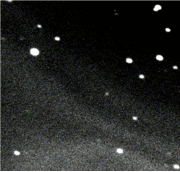


99942 Apophis (pronounced /əˈpoʊfɪs/, previously known by its provisional designation 2004 MN4) is a near-Earth asteroid that caused a brief period of concern in December 2004 because initial observations indicated a relatively large probability (up to 2.7%) that it would strike the Earth in 2029. Additional observations provided improved predictions that eliminated the possibility of an impact on Earth or the Moon in 2029. However there remained a possibility that during the 2029 close encounter with Earth, Apophis would pass through a gravitational keyhole, a precise region in space no more than about 400 meters across, that would set up a future impact on April 13, 2036. This possibility kept the asteroid at Level 1 on the Torino impact hazard scale until August 2006. It broke the record for the highest level on the Torino Scale, being, for only a short time, a level 4, before it was lowered.
Additional observations of the trajectory of Apophis revealed the "keyhole" would likely be missed and on August 5, 2006, Apophis was lowered to a Level 0 on the Torino Scale. As of October 19, 2006, the impact probability for April 13, 2036, was calculated as 1 in 45,000. An additional impact date in 2037 was also identified; the impact probability for that encounter was calculated as 1 in 12.3 million.
In April 2008 news organizations, following a publication by the German tabloid Bild, widely reported that 13 year-old Nico Marquardt from Potsdam, Germany, had recalculated the odds as part of a science competition, and found the risk had been underestimated. His project took into account the possibility that the asteroid would collide with one or more of the estimated 40,000 artificial satellites orbiting Earth, possibly causing a shift in its orbit, and increasing the probability of a collision with Earth on its next fly-by in 2036 to 1 in 450.
Initial news reports claimed that NASA confirmed these results with the ESA. An unnamed German ESA spokesman told The Register on April 16, 2008 "A small boy did do these calculations, but he made a mistake... NASA's figures are correct." On the same day, in press release 08-103, NASA spokesman Dwayne Brown denied that NASA had had any contact with Marquardt; had not changed its risk assessment; and said "...the asteroid will not pass near the main belt of geosynchronous satellites in 2029, and the chance of a collision with a satellite is exceedingly remote." Some scientists have also denied the claims that the effects of a collision with a satellite would be strong enough for such an influence on the trajectory of the asteroid.
 Indonesia watch out Tsunami from the north....
Indonesia watch out Tsunami from the north....
No comments:
Post a Comment